
Why A Smart Technology Strategy Is Now the Fastest Path to Growth
TLDR
Over the past 20 years, technology has transformed from a back-office expense into a frontline growth driver. This article traces that shift, from cloud and SaaS to AI and platform thinking, through real examples, founder insights, and market data.
Key takeaways:
• Founders who align tech with business outcomes outperform those who treat it as overhead.
• Cloud, Agile, DevOps, and AI aren’t just trends—they’re levers for speed, learning, and scale.
• Modern tech strategy means embedding data, platforms, and product thinking into every part of the business.
• Winning companies use tech to create unique customer value, streamline operations, and unlock sustainable growth.
Bottom line:
Technology isn’t the support act anymore, it’s the growth strategy.
And if your tech team isn’t driving traction, revenue, or retention, you’re leaving value on the table.
The Wake-Up Call

It’s 7am on New Year’s Day and I’m staring at a frozen server dashboard. A client’s critical launch, for their golden quarter of sign-ups and subscriptions, has just collapsed under a DDoS attack. No time for celebration, no time for excuses. We triaged, we reconfigured, we re-routed, we fought hard, it was brutal battle that lasted 9 hours before the server was able to serve customers again. What hit me hardest wasn’t the outage, it was the realisation that technology had stopped being “just IT.” In that moment, it was the difference between success and failure, growth and stagnation.
Fast forward to today, and that shift isn’t just anecdotal, it’s systemic. Over the past 20 years, technology has moved from the back office to the boardroom. Once seen as overhead, it’s now the engine powering product innovation, customer experience, and commercial agility. It’s how businesses unlock new revenue streams, gain a competitive edge, and deliver measurable business value.
And yet, some leaders still treat it like a sunk cost.
This article is for the ones who don’t.
It’s for founders, scale-up CEOs, and decision-makers who want their tech strategy to drive outcomes, not invoices. Who see technology not just as an enabler, but as a strategic weapon aligned to core business goals.
We’ll trace the transformation from cost centre to growth catalyst, draw a line through the milestones that mattered (cloud, Agile, AI, platforms), and extract the practical takeaways that separate the winners from the well-meaning.
Because the real question isn’t whether technology can grow your business.
It’s whether you’ve built your business to let it.
• • •
A 20-Year Shift in the Tech Mindset

From Ticket-Takers to Growth Architects
Back in 2005, IT was the place good ideas went to die. You’d come in with a bold vision, a new feature, a new product line, and walk out with a timeline in quarters and a budget in red. Tech was treated like plumbing: essential but invisible, and definitely not strategic.
I remember sitting in board meetings trying to justify technology investments like they were a defensive spend. “This upgrade will reduce downtime.” “This system will make reporting easier.” That was the language, defensive, incremental, risk-averse.
Fast-forward two decades, and that mindset is not just outdated, it’s dangerous and I wont play a part in it. The highest-growth companies today don’t treat tech as a cost to contain. They treat it as a competitive asset that drives differentiation, efficiency, and growth. And that shift isn’t about buzzwords. It’s about aligning technological capabilitieswith real commercial outcomes.
In my own ventures, the transformation became obvious when I stopped treating technology as a department and started treating it as a core part of the business model. When tech teams had a seat at the commercial table, defining products, owning outcomes, and influencing business operations, things accelerated. Not because the stack changed overnight, but because the expectations did.
The lesson? You don’t have to be Amazon or Google to make this shift. But you do need to stop running your tech team like a cost centre and start leading it like a growth engine. That means rethinking what success looks like. It’s no longer uptime or “on budget”,it’s impact, adaptability, and strategic lift.
Ask yourself:
Are your technology investments driving outcomes, or just keeping the lights on?
Are your teams shaping the future of your business operations, or reacting to it?
The companies that will win the next decade already know the answer.
• • •
Why Cloud + SaaS Changed the Growth Equation
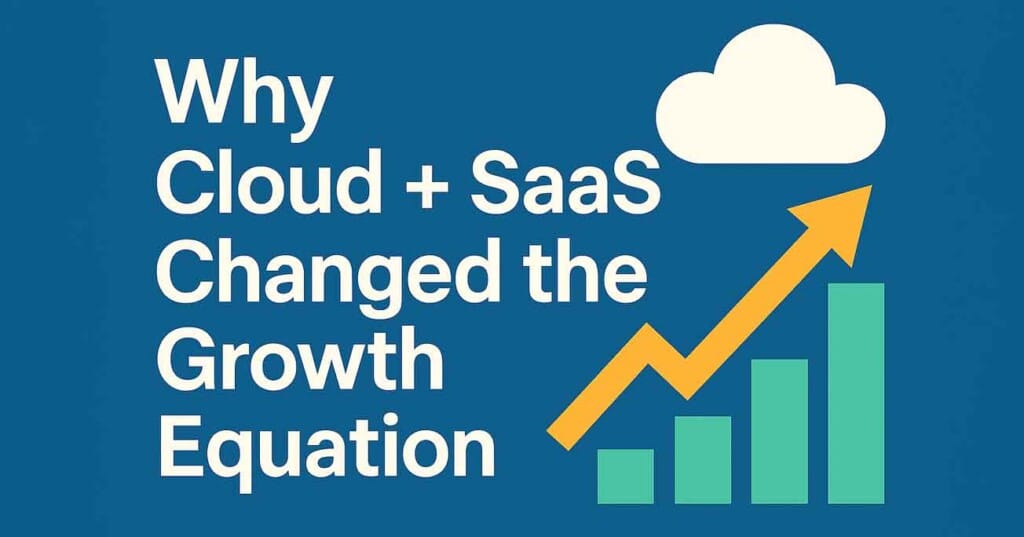
Infrastructure became a lever, not a liability.
The first time I moved a product to the cloud, I didn’t do it to “innovate.” I did it because I was sick of waiting, sick of procurement bottlenecks, server downtime, and engineers burning cycles on infrastructure instead of features. What I didn’t expect was just how radically it would accelerate our ability to test, learn, and grow.
This is the underrated truth about cloud and SaaS: they didn’t just reduce IT costs, they collapsed the gap between idea and impact. They reshaped what a modern IT strategy could deliver, fast iteration, global scalability, and real commercial outcomes.
When Amazon Web Services launched in 2006, it looked like a clever way to rent servers. What it actually did was dismantle the old information technology strategy model. Suddenly, a startup could run like a scaled enterprise. No server rooms. No six-month lead times. Just raw capability, on tap.
SaaS followed the same arc. Tools like Salesforce, Slack, and later Figma or Notion let teams move fast without waiting on internal builds or brittle integrations. For founders, it meant focus. You could outsource the undifferentiated heavy lifting and put your best minds on building the parts of the product that actually drive competitive advantage.
In one of my previous businesses, we rebuilt a client’s core analytics stack using a mix of SaaS tools and cloud-native components. The old system had taken nine months to build and six to maintain. The new one? Eight weeks to launch. Zero internal support needed. And more importantly, it gave their commercial team the insight and customer data they needed to double trial conversions in under a quarter.
Cloud and SaaS didn’t just change IT, they changed what was possible. Especially for underdog companies. They rewrote the rules of scale, agility, and value creation. And they became the backbone of a modern technology strategy framework, where every piece of infrastructure exists to enable faster experimentation, smarter data driven decision making, and tighter alignment to business goals.
You don’t need deep pockets anymore.
You need conviction, curiosity, and the guts to move fast.
Here’s the takeaway:
If your tech stack still reads like a procurement spreadsheet instead of a product roadmap, you’re not just behind—you’re vulnerable.
Cloud is no longer a cost-saving exercise. It’s your growth scaffolding. Build on it, or get out-built.
• • •
Agile + DevOps = Competitive advantage
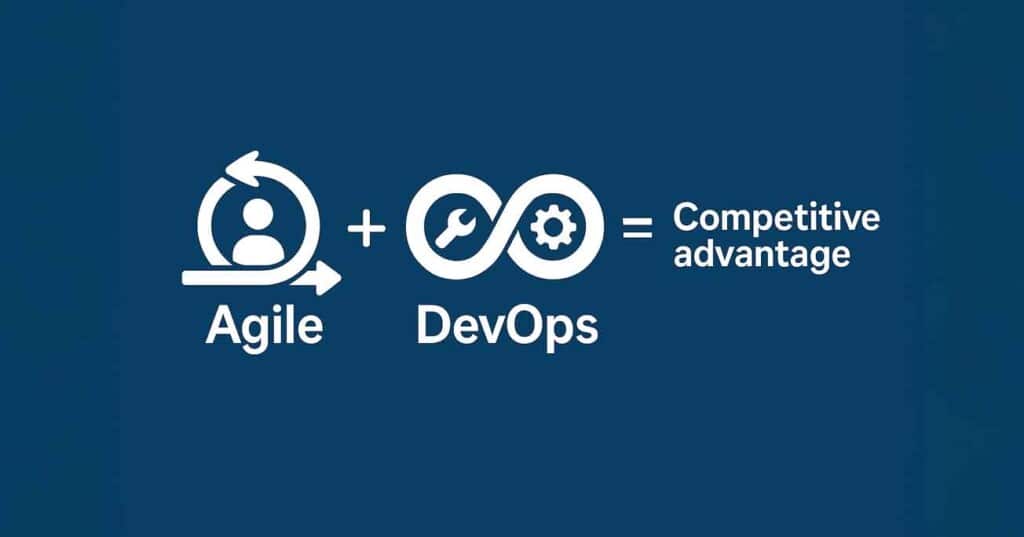
Velocity isn’t about shipping faster. It’s about learning faster.
One of the biggest mindset shifts I’ve seen over the years? Realising that speed doesn’t just save money, it unlocks momentum. That’s what Agile and DevOps really did. They turned tech from a project based treadmill into a flywheel for growth, and a powerful part of any scale-up’s growth strategy.
When I first introduced Agile in my previous agency business, it felt awkward. Too many post-its, not enough delivery. But once the team settled in, something clicked. Engineers weren’t just building, they were co-owning the product. Business leaders weren’t just signing off, they were shaping every sprint. And suddenly, we were learning faster than our competitors.
Agile alone wasn’t enough though. It’s DevOps that made it hum.
Before DevOps, launching a new feature felt like crossing a minefield, handoffs, deployments, support chaos. After DevOps? Our engineers owned what they shipped. Infrastructure was code. Releases were small, frequent, reversible. We were no longer guessing what users wanted, we were testing it live, iterating fast, and delivering real results in weeks, not quarters.
Here’s what most non-technical founders miss:
Agile isn’t a methodology. DevOps isn’t a tooling choice. Together, they’re a commercial advantage.
And that advantage isn’t theoretical, the numbers prove it. High-performing teams deploy code hundreds of times more frequently than low performers, and with dramatically fewer failures. That means every piece of customer data can feed your next feature. That means your technology solutions can evolve in real time to meet shifting user expectations.
I’ve seen companies fall into the trap of hiring a great team, then shackling them with waterfall governance and fixed technology roadmaps. That’s like buying a sports car and insisting it stays in first gear.
If your delivery cadence still sounds like, “Q4 roadmap” or “targeting an April release,” ask yourself this:
What would it look like if your tech team was designed for speed-to-learning?
How much closer could you get to your business mission if iteration was your default mode?
This is where real growth lives, not in the line of code, but in how fast you find out whether it works. It’s a shift that every modern technology leader must champion if they want to turn tech from a department into a driver.
• • •
Data, Artificial Intelligence, and the Rise of Intelligent Products

Your real product might be hiding in your data exhaust.
There was a time when data was something you used to generate reports. Now? It’s your differentiator. Your moat. Your unfair advantage, if you know how to build around it.
In one of my ventures, we hired our first data scientist not because it was trendy, but because we had a hunch: buried in user behaviour was insight we hadn’t yet tapped. Within two months, we were using that data to personalise onboarding, tweak pricing, and predict churn. It wasn’t just a shift in tooling, it was a shift in thinking. We moved from instinct to signal. From assumptions to insights.
That’s the real unlock when you treat data as a strategic asset, part of your technology framework, not just a dashboard output.
This is where leveraging technology turns tactical changes into strategic leaps. Suddenly you’re not just improving a product, you’re building a unique market proposition, grounded in what your customers actually do, not just what they say.
Then came Artificial Intelligence (AI).
Early on, I saw founders bolt on AI like it was a PR stunt, “Now with machine learning!” But the smart ones embedded AI into their business logic: smarter recommendations, automated workflows, predictive logic. Not gimmicks. Multipliers.
And now with the rise of generative AI, from hyper-personalised content to lightning-fast legal summaries, technological innovation is moving faster than most roadmaps can keep up with. Startups with no AI team at all are now using pre-trained models to ship features that would’ve cost millions just a few years ago.
This is what real digital transformation looks like. It’s not adopting buzzwords, it’s streamlining processes, improving operational efficiency, and delivering new kinds of value using cutting edge technologies.
But here’s the truth:
AI without data is a blunt instrument.
AI with proprietary, structured, actionable customer data? That’s a technology strategy framework that scales.
So the question for scale-ups isn’t “Should we adopt AI?” It’s:
“What do we know, see, or track that others don’t—and how do we turn that into customer value?”
The best companies don’t just adopt technological advances, they build around them. They anchor their IT strategy in access to rich data and fast learning loops. They stay ahead by designing systems that adapt to future trends, not just today’s feature requests.
Your opportunity?
Stop asking what data you have, start asking what data you’re underusing.
That’s where the product is. That’s where the next lift lives.
That’s where the customer says, “Finally, someone built this for me.”
• • •
Platform Thinking for Non-Platform Businesses
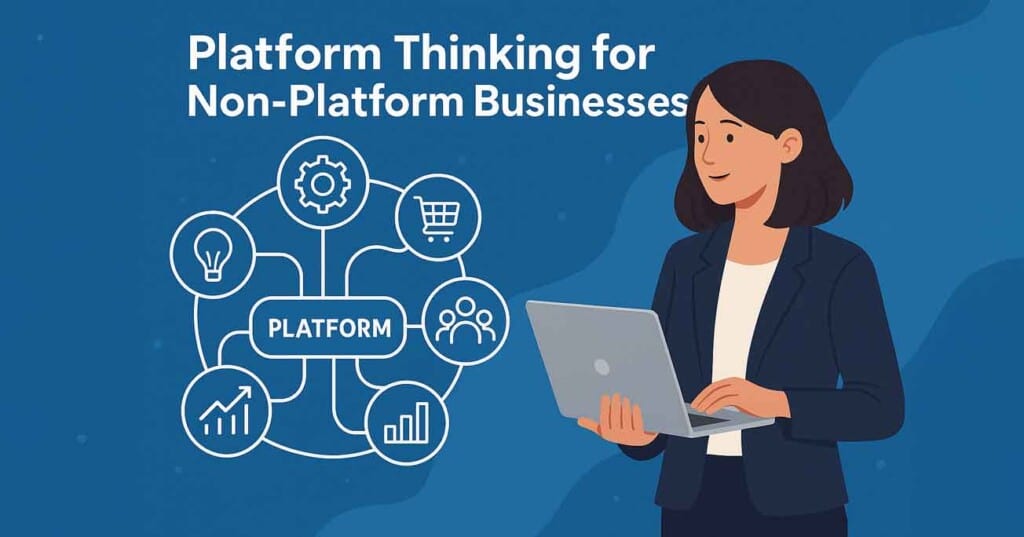
The fastest-growing companies aren’t selling services—they’re enabling ecosystems.
Most founders build products. The best ones build platforms.
The distinction isn’t just semantic, it’s strategic. A product solves a problem. A platform solves problems at scale—by letting others plug in, extend, and contribute. And it’s this model, tech as an ecosystem enabler, that’s quietly been fuelling sustainable growth for some of the world’s most leading organisations.
Here’s the wake-up call:
If your tech stack only serves your internal teams, you’re leaving growth on the table.
If your product doesn’t connect, integrate, or empower others, it’s a bottleneck, not a multiplier.
Take Amazon. It turned internal infrastructure into AWS and built a $100B platform business. Shopify started as a simple store builder and evolved into a full commerce ecosystem, developers, agencies, and toolmakers all adding value. Stripe didn’t just sell payments, it created infrastructure for startups, powered by clean data architecture and developer-first APIs.
In one of my ventures, we started as a service provider. But when we opened up parts of our tech—simple APIs, accessible modules, something changed. Partners built on top. Customers embedded us into their customer journey. We weren’t just a tool anymore, we were infrastructure. Stickiness went up, support requests went down, and new revenue streams emerged naturally through organic growth.
That’s what platforms do:
- Unlock new customer segments without new overhead.
- Generate valuable insights from partner behaviour.
- Streamline operations by letting others expand the value of your stack.
This doesn’t mean you need an app store by Friday. It means asking:
- What assets could we expose safely and smartly?
- Where are we gatekeeping value that others could amplify?
- Could our internal tools solve someone else’s problem, at scale?
Even small moves—an embeddable widget, a public API, modular design, can begin the shift from product to platform. And when that happens, network effects kick in. That’s the turning point, from linear effort to exponential returns.
Leading organisations already see this. They’re architecting for scale, not just scope. They’re leveraging data access, not hoarding it. They’re using new technologies to multiply reach and reduce friction.
Founders often say, “We’re not a platform business.”
But here’s the thing: you could be.
And in a market where integration is currency and scale is speed, platform thinking might just be the most commercial move you make for long-term, sustainable growth.
• • •
Organisational Shifts to Business Processes
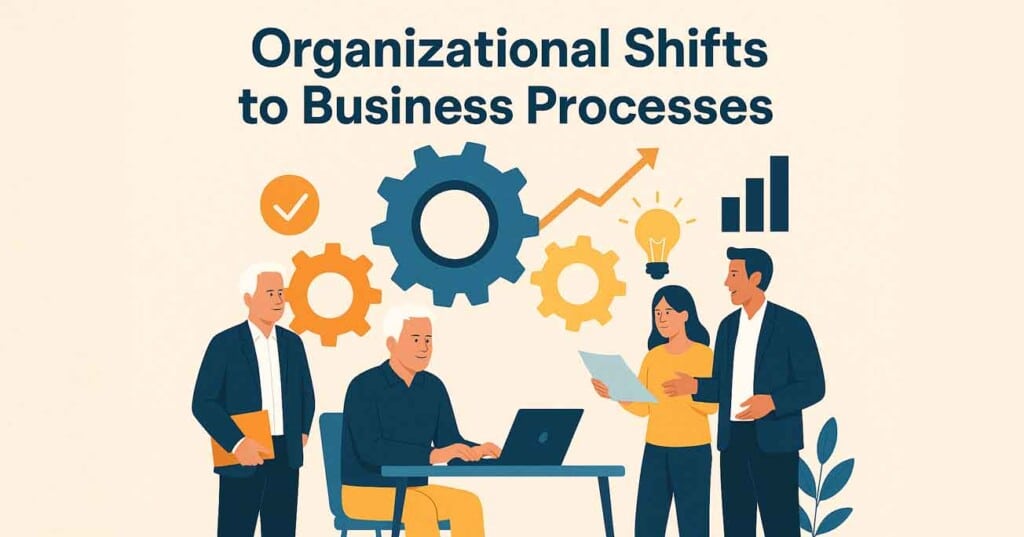
Structure drives speed. Culture drives compounding.
You can have the best tech stack in the world, cloud-native, AI-powered, API-rich, but if your organisation is still wired for 2005, it’ll stall. How you structure your teams and culture determines how fast you can grow, scale, and adapt to evolving business needs.
One of the biggest unlocks in my journey was moving from project-based teams to product squads. Cross-functional groups that owned an outcome, not a deliverable. That innovative approach redefined collaboration. Suddenly, engineers, product managers, and designers weren’t asking, “What are we building this sprint?” but “What impact are we aiming for this week?” That mindset shift changed everything.
We stopped tracking delivery. We started tracking traction.
This shift embedded key elements of growth into the way teams worked, velocity, autonomy, and alignment. The difference between a tech team and a tech organisation? A tech team builds what they’re told. A tech organisation drives the roadmap, the business plan, and, if you let them, the next phase of scale.
That’s why I believe today’s CIO or CTO isn’t just a tech exec, they’re a strategic co-pilot. In every startup or scale-up I’ve advised, the most successful ones have this in common: a technology leader who thinks like a founder. They’re in board meetings. They set targets. They ask questions like, “What new systems can we deploy to shorten the sales cycle?” or “Where are we losing value across our supply chain?”
They’re also leading internal culture change, transforming IT from the “department of no” into a centre of acceleration. From blockers to builders. From legacy to lean.
But here’s the reality:
This kind of shift takes guts.
You have to kill old processes. Flatten hierarchies. Empower squads. Invest in actionable insights, not just dashboards. And that’s uncomfortable, especially in companies where control feels like the only thing holding things together.
Still, here’s the hard truth:
You can’t deliver modern products with a pre-cloud org chart.
You can’t act like a digital company if your engineers need sign-off to push code.
You can’t claim agility if your tech team isn’t trusted to act on cost reduction opportunities and customer feedback in real time.
The companies pulling ahead?
They’re not just launching features, they’re rethinking how they work. They improve communication across functions. They break down silos. They give their teams the permission and clarity to move fast.
Ask yourself:
- Do your teams own outcomes, or just outputs?
- Is your org structured to scale ideas, or just ship features?
- Is your CTO empowered to drive growth, or just delivery?
Those answers will tell you more about your future than your entire technology roadmap.
• • •
Evidence Over Hype, Business Growth from Tech Done Right
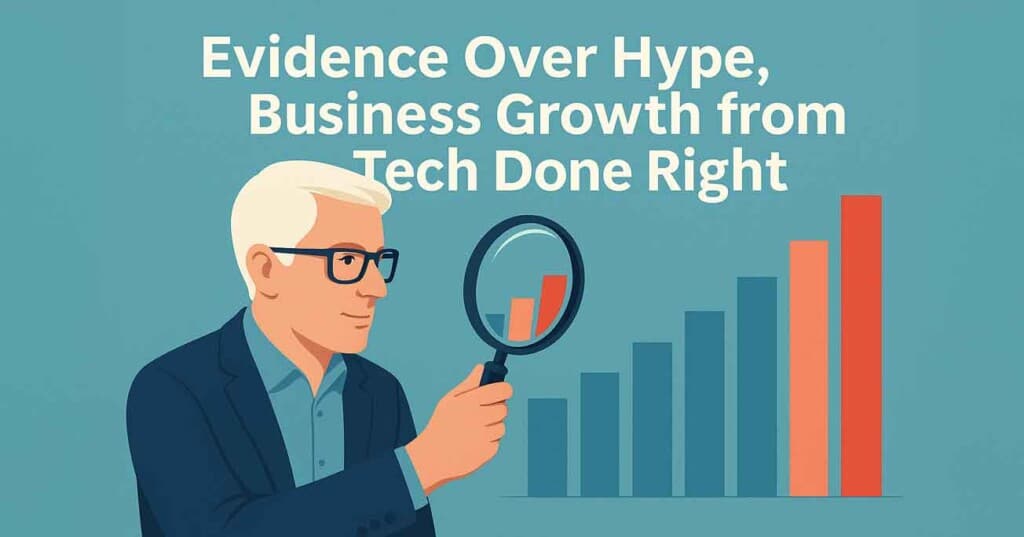
Growth is not a side effect. It’s the design.
Let’s drop the theory for a minute and talk about results, because when tech is done right, the numbers do the talking.
Take Domino’s. Not exactly the first brand that screams digital innovation. But in the 2010s, they bet hard on online ordering, app UX, and data-driven marketing, built on solid data management foundations. The result? A pizza company that outperformed Apple and Amazon in share price growth over nearly a decade. Why? Because they treated tech as part of the customer experience, not just the ordering system.
Same with Stripe. It tackled one of the ugliest parts of online business, payment processing, and turned it into a dev-first platform. Their internal motto wasn’t “be a fintech,” it was “build a great product for builders.” That product now powers the back end of millions of companies, enabling them to access data, automate billing, and scale without rethinking their infrastructure.
Netflix is another standout. Its pivot from DVDs to streaming wasn’t just a shift in delivery, it was a reimagining of enterprise architecture. From custom infrastructure to chaos engineering to a predictive content model, they used emerging technologies to create a moat legacy media couldn’t replicate. Their growth didn’t just come from what they showed, but from how they delivered it.
What these companies got right wasn’t just the tooling. It was the commercial logic:
- They linked tech to revenue levers.
- They made product teams accountable for the right metrics (conversion, retention, margins).
- They moved fast, learned faster, and stayed close to their customers.
And the impact? It’s quantifiable:
- BCG found that companies embedding tech into their core outperformed peers by 3x in shareholder returns.
- McKinsey reported that digital-ready firms recovered faster and fuelled economic growth post-COVID.
- Gartner says 79% of CIOs now see themselves as strategic business partners, not just IT guardians.
That’s not noise. That’s a signal.
In my own work, I’ve seen the highest ROI come not from big-bang rebuilds, but from teams who:
- Build for outcomes.
- Leverage emerging technologies with purpose.
- Use fast loops and real customer data to adapt.
Because growth doesn’t come from investment alone, it comes from alignment. From designing your tech to improve key metrics, support your business model, and reinforce your unique market position.
The litmus test is simple:
When you launch new tech, does revenue go up, churn go down, or margins improve?
If not, you’re investing in technology.
But you’re not investing in growth.
• • •
Conclusion – The Founder’s Growth Playbook for 2025

Technology is your steering wheel, not your seatbelt.
I’ve seen this shift play out across startups, scale-ups, and even global brands, and lived it myself. In 2005, tech was overhead. In 2025, it’s outpacing product, sales, and even brand as the primary lever of growth.
The difference between companies that thrive and those that stall?
It’s not capital. It’s not talent.
It’s how they treat their technology function.
The old model:
- IT reports to Finance.
- Roadmaps are static.
- “Tech” means maintenance.
The new model:
- Tech leads sit beside the CEO.
- Feedback loops are tight.
- Product is the growth engine.
And here’s the most important part: this shift is available to you.
Right now. No matter your size or sector.
You don’t need to be a tech company. But you do need to act like one.
That means:
- Building teams that own outcomes, not deliverables.
- Designing systems that scale customer value, not complexity.
- Investing in learning velocity, because whoever adapts fastest, wins.
In my world, I no longer separate tech from business strategy. Because they’re the same thing. And when you build like that, from a position of insight, speed, and boldness, growth stops being a goal and starts being a consequence.
• • •
Let’s Talk.
If your tech still feels like a cost centre, I can help you flip the model.
Let’s have a conversation about how turning a technology strategy into a growth driver, not a bottleneck.
Drop me a line. Let’s build something that moves the needle.
• • •